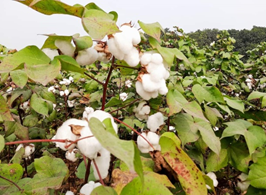

7th April 2023 (7 Topics)
Context
The two-day Annual Group Meeting 2022-23 of All India Coordinated Research Project (AICRP) on cotton crop commenced at Punjab Agricultural University (PAU), Ludhiana.
|
All India Coordinated Research Project (AICRP):
|
About the meet:
- There is a need to speed-up the process of varietal development, especially, the hybridisation programme of cotton by placing focus on Bt gene, large boll size, resistance towards diseases and mechanical harvesting.
- Delegates from various state agricultural universities and ICAR institutes and agricultural experts from PAU attended the inaugural session.
- Cotton is a cash as well as commercial crop combating the pressing challenge of climate crisis.
- Concern over the challenge of Pink Bollworm management in the central, north and south zones and urged the experts to step up the efforts in this regard.
- The problem of monsoon deficit was also highlighted.
- Pointing out the issue of low cotton production and productivity, all assured of releasing a few varieties for the High Density Planting System (HDPS).
|
India, Bangladesh, Egypt and Pakistan were the largest consumers of cotton. India also produces various cotton varieties and hybrids, and the area under this crop in Punjab, Maharashtra, Rajasthan, Gujarat, etc. |
India’s Cotton production:
- India is one of the largest producers of cotton in the world accounting for about 23% of the world cotton production.
- The yield per kgs hectare which is presently 465 kgs/ha is still lower against the world average yield of about 755 Kgs /ha.

Cotton farming patterns:
- It is a Kharif crop that comes from the natural fibres of cotton plants, which are native to tropical and subtropical regions.
- Being renewable and biodegradable, cotton is the most environmentally friendly raw material for the textile industry as compared to its synthetic alternatives.
- Cotton plants have a large growing period which can extend up to 200 days.
- Growing cotton starts between December and March.
- These plants require a relatively high temperature (21-30°C) over a long growing season.
- Cotton is a less water-intensive crop as it is a xerophyte, which can grow in dry, arid environments.
Varieties of cotton:
- India is the country to grow all four species of cultivated cotton;
- arboreum
- Herbaceum (Asian cotton)
- barbadense (Egyptian cotton)
- hirsutum (American Upland cotton).
- hirsutum represents 94% of the hybrid cotton production in India and all the current Bt cotton hybrids are G. hirsutum.
- India is the only country that grows cotton as hybrids and the first to develop hybrid cotton back in 1970.
About Bt-Cotton:
- Bt Crops are transgenic crops that produce the same toxin as the bacterium Bacillus thuringiensis in the plant cell, thereby, protecting the crops from pests.
- The bacterium secretes specific proteins known as “cry proteins” that are toxic to insects.
|
Bacillus thuringiensis: Bacillus thuringiensis is a gram-positive, spore-forming bacterium which is mainly found in the soil. As stated above, it produces proteins that are toxic to insects. Organic farmers use this bacterium in a solution and spray it on the plants to protect them from pests. |
- The Bt cotton variety is genetically transformed with the Bt gene to protect the plants from bollworm, a major pest of cotton.
- The worms present on the leaves of Bt cotton become lethargic and sleepy and thus, cause less damage to the plants.
- When the worms consume the plant, the toxic proteins produced by the crops are ingested, thereby, killing them.
Concerns associated in Cotton production:
- India’s cotton fields are vulnerable to insect infestation, which lowers both output and quality.
- Many factors, including lack of crop rotation, monoculture, adverse weather, poor soil quality, inadequate pest control, etc., contribute to pest infestation in cotton crops.
- India produces less cotton per hectare than other significant cotton-producing nations.
- This is mostly caused by the employment of out-of-date farming techniques, insufficient irrigation systems, and subpar seed quality.
- Small-scale cotton farmers in India struggle to make ends meet due to the high cost of inputs including seeds, fertilizer, and insecticides.
- The success of India’s cotton crop is primarily dependent on the monsoon rains, which may be inconsistent and unexpected.
- There are a lot of indebted cotton farmers in India, which might result in a vicious cycle of debt and poverty.
- As they have no access to markets, many Indian cotton producers are compelled to sell their products to intermediaries for poor rates.
Government Interventions:
- Integrated Pest Management (IPM) programme: Government of India has adopted Integrated Pest Management (IPM) as cardinal principle and main plank of plant protection in the overall Crop Production Programme since 1985.
- IPM is an eco-friendly approach which encompasses cultural, mechanical, biological and need based chemical control measures.
- National Policy on IPM: The indiscriminate and unilateral use of pesticides was the only plant protection tool during sixties and seventies for sustaining of agricultural production potential of the high yielding varieties under the intensive cropping systems.
- This has led to several ill-effects like human and animal health hazards, ecological imbalance, development of resistance in the pests to pesticides, pests’ resurgence and environmental pollution as well as destruction of natural enemies (bio-control agents) of pests and increased level of pesticides residues in soil, water, food with the increased use of pesticides.
- Activities:- The 31 Central Integrated Pest Management Centers (CIPMCs) located in 28 States and one Union Territory undertakes the programme with following activities:
- Surveillance & Monitoring of insect-pest & diseases.
- Augmentation and Conservation of Natural enemies.
- Production and release of bio-control agents
- Human Resource Development (HRD) through Farmers’ Field Schools (FFSs) Season-long training programmes, orientation training programme and refresher courses.


